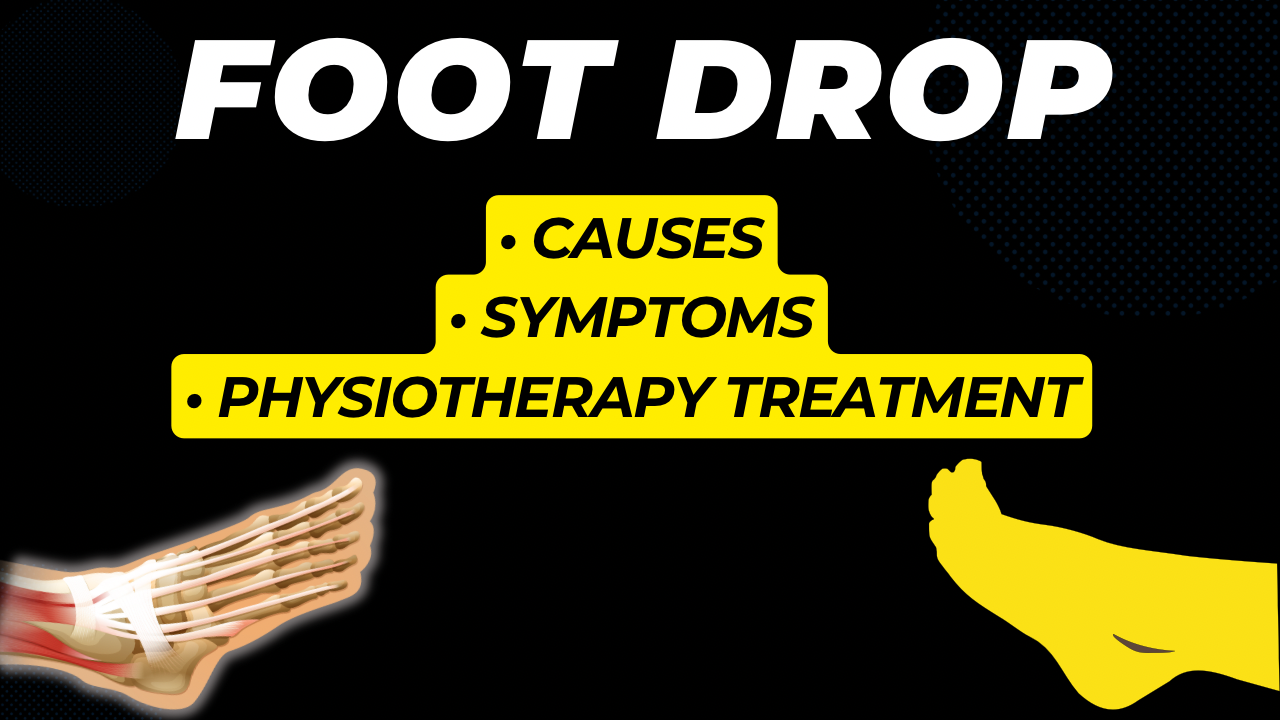Foot Drop: Causes Symptoms and Physiotherapy Treatments
Foot drop, also known as drop foot, is a neuromuscular disorder that affects a person’s ability to lift the front part of their foot while walking.
This condition can significantly impact an individual’s mobility, balance, and quality of life.
In this comprehensive article, we’ll explore the causes, symptoms, and most importantly, the various physiotherapy treatments available for foot drop.
What is Foot Drop?
Foot drop is characterized by the inability to lift the front part of the foot, causing it to drag along the ground while walking.
This condition typically affects one foot, but in some cases, it can occur bilaterally.
The primary muscles involved in lifting the foot are the tibialis anterior, extensor hallucis longus, and extensor digitorum longus, which are collectively responsible for dorsiflexion of the ankle.
Causes of Foot Drop
Foot drop can result from various underlying conditions, including:
- Nerve injuries: Damage to the peroneal nerve, which controls the muscles responsible for lifting the foot, is a common cause.
- Neurological disorders: Conditions such as multiple sclerosis, stroke, or cerebral palsy can lead to foot drop.
- Muscular disorders: Muscular dystrophy or other muscle-weakening conditions may contribute to foot drop.
- Spinal cord injuries: Trauma to the spinal cord can affect nerve signals to the foot and ankle muscles.
- Diabetes: Peripheral neuropathy associated with diabetes can cause foot drop.
- Hereditary factors: Some genetic disorders can predispose individuals to foot drop.
Symptoms of Foot Drop ( Foot Drop: Causes Symptoms and Physiotherapy Treatments )
The primary symptoms of foot drop include:
- Difficulty lifting the front part of the foot while walking
- Dragging of the toes on the ground
- High steppage gait (lifting the knee higher than normal to clear the foot)
- Numbness or tingling sensation in the lower foot or leg
- Weakness in the ankle or foot muscles
- Increased risk of tripping or falling
Physiotherapy Treatment for Foot Drop
Physiotherapy plays a crucial role in managing foot drop and improving a patient’s mobility and quality of life.
Here are some effective physiotherapy treatments for foot drop:
Strengthening Exercises:
Targeted exercises to strengthen the muscles responsible for dorsiflexion are essential. These may include:
- Toe raises: Lifting the toes while keeping the heel on the ground
- Ankle dorsiflexion: Using resistance bands to lift the foot against resistance
- Tibialis anterior strengthening: Specific exercises to target this key muscle
Range of Motion Exercises:
Maintaining and improving ankle flexibility is crucial. Physiotherapists may recommend:
- Ankle rotations
- Gentle stretching of the calf muscles
- Active and passive ankle movements
Gait Training:
Retraining the walking pattern is vital for patients with foot drop. This may involve:
- Treadmill training with body weight support
- Obstacle course navigation
- Practicing proper heel-to-toe walking
Balance and Proprioception Exercises:
Improving balance and body awareness can help prevent falls. Exercises may include:
- Single-leg standing
- Wobble board exercises
- Tai Chi or yoga-inspired movements
Electrical Stimulation:
Functional electrical stimulation (FES) can be used to activate the weakened muscles. This involves:
- Placing electrodes on the skin to stimulate the tibialis anterior muscle
- Using portable FES devices during walking to lift the foot
Orthotics and Assistive Devices:
Physiotherapists may recommend:
- Ankle-foot orthoses (AFO) to support the foot and ankle
- Specially designed shoes with built-in support
- Walking aids such as canes or walkers for added stability
Soft Tissue Techniques:
Manual therapy can help address any muscle tightness or restrictions:
- Massage of the calf and shin muscles
- Myofascial release techniques
- Trigger point therapy
Neuromuscular Re-education:
Techniques to improve the brain-muscle connection may include:
- Mirror therapy
- Mental imagery exercises
- Biofeedback training
Aquatic Therapy:
Water-based exercises can be beneficial, offering:
- Reduced weight-bearing stress on joints
- Resistance for muscle strengthening
- A safe environment for gait training
Home Exercise Program:
Physiotherapists will design a tailored home exercise program to ensure continued progress between sessions.
The Importance of Early Intervention
Early diagnosis and treatment of foot drop are crucial for optimal outcomes.
Prompt physiotherapy intervention can help prevent muscle atrophy, maintain joint mobility, and potentially restore function more effectively.
Additionally, early treatment can reduce the risk of secondary complications such as falls or development of compensatory movement patterns.
Multidisciplinary Approach
While physiotherapy is a cornerstone of foot drop treatment, a multidisciplinary approach often yields the best results.
This may involve collaboration with:
- Neurologists for underlying condition management
- Orthotists for custom orthotic devices
- Occupational therapists for daily living adaptations
- Podiatrists for foot health and appropriate footwear
Conclusion ( Foot Drop: Causes Symptoms and Physiotherapy Treatments )
Foot drop can be a challenging condition, but with proper physiotherapy treatment, many patients can experience significant improvements in their mobility and quality of life.
The key to success lies in a comprehensive, individualized approach that addresses muscle strength, flexibility, gait patterns, and overall functional ability.
By combining various physiotherapy techniques, utilizing appropriate assistive devices, and maintaining a consistent home exercise program, individuals with foot drop can work towards regaining independence and confidence in their daily activities.
If you or someone you know is experiencing symptoms of foot drop, it’s essential to seek professional medical advice and begin a tailored physiotherapy program as soon as possible.
With dedication and the right treatment approach, many individuals can overcome the challenges posed by foot drop and return to a more active, fulfilling lifestyle.

Good information
Thank you keep share the link and help me in spreading awareness , you can check out more videos on our physio talk you tube channel